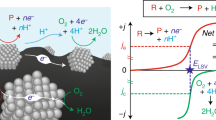Abstract
This article describes a joint redox mechanism that, using the example of water synthesis in the presence of certain metal oxides, explains the important thermodynamic features of this mechanism. This study is based on a comparison of the total enthalpy of the formation of ΔfHT redox reaction components with the reaction energy E spent when its temperature rises. Taking into account the number of moles of the resulting products of the reduction-oxidative reaction (atoms and molecules), the reaction mode (equimolar and isobaric), and the law of conservation of energy, these values should be equal. Analysis of a number of reactions differing in metal oxides (Ag2O, NiO, PtO2) and reducing gases (H2, CO, SO2), taking into account some self-cooling of the oxides during their reduction confirmed these expectations. The theoretical estimates are in reliable agreement with the experimental data. As a result of our research, the 200-year-old mystery of water synthesis, described by Sir Humphrey Davy in 1817, was solved by us based on the modern physicochemical concepts, not related to catalysis.

Similar content being viewed by others
REFERENCES
Robertson, A.J.B., The early history of catalysis, Platinum Met. Rev., 1975, vol. 19, pp. 64–69.
Davy, H., Some new experiments and observations on the combustion of gaseous mixtures, Philos. Trans. R. Soc., 1817, vol. 107, pp. 77–83.
Berzelius, J.J., The tails are on a new increasing force in the combinations of organized bodies, Ann. Chim. Phys., 1836, vol. 61, pp. 146–151.
Faraday, M., On the power of metals and other solids to induce the combination of gases, Philos. Trans. R. Soc., 1834, vol. 124, pp. 55–76.
L’vov, B.V., The analytical use of atomic absorption spectra, Spectrochim. Acta, Part A, 1961, vol. 17, pp. 761–770.
L’vov, B.V., Mechanism of thermal decomposition of nitrates from graphite furnace mass spectrometry studies, Microchim. Acta, 1991, vol. 2, pp. 299–308.
L’vov, B.V., The physical approach to the interpretation of the kinetics and mechanism of thermal decomposition of solids: the state of the art, Thermochim. Acta, 2001, vol. 373, pp. 97–124.
L’vov, B.V., Termorazlozhenie tverdykh i zhidkikh veshchestv (Thermal Decomposition of Solid and Liquid Substances), St. Petersburg: Politekh. Univ., 2006.
L’vov, B.V., Thermal Decomposition of Solids and Melts. Thermochemical Approach to the Mechanism, Kinetics and Methodology, Budapest: Springer-Verlag, 2007.
L’vov, B.V. and Galwey, A.K., Interpretation of the kinetic compensation effect in heterogeneous reactions: thermochemical approach, Int. Rev. Phys. Chem., 2013, vol. 32, pp. 515–557.
Pease, R.N. and Taylor, H.S., The catalytic formation of water vapor from hydrogen and oxygen in the presence of copper and copper oxide, J. Am. Chem. Soc., 1922, vol. 44, pp. 1637–1647.
Benton, A.F. and Elgin, J.C., The catalytic synthesis of water vapor in contact with metallic silver, J. Am. Chem. Soc., 1926, vol. 48, pp. 3027–3046.
Richardson, J.T., Scates, R., and Twigg, M.V., X-ray study of nickel oxide reduction by hydrogen, Appl. Catal., A, 2003, vol. 246, pp. 137–150.
Lewis, B. and von Elbe, G., Combustion, Flames and Explosions in Gases, New York: Academic, 1961.
Gurvich, L.V., Veits, I.V., and Medvedev, V.A., Termodinamicheskie konstanty individual’nykh veshchestv. Spravochnik (Thermodynamic Constants of Individual Substances: Handbook), Moscow: Nauka, 1978, vol. 1, part 1.
Glushko, V.P., Termicheskie konstanty veshchestv, Spravochnik, Vyp. 4, Chast’ 1: Tablitsy prinyatykh znachenii (Thermal Constants of Substances: Handbook, Vol. 4, Part 1: Tables of Accepted Values), Moscow: Akad. Nauk SSSR, 1972.
Gentry, S.J., Firth, J.G., and Jones, A., Catalytic oxidation of hydrogen over platinum, J. Chem. Soc., Faraday Trans., 1974, vol. 70, pp. 600–604.
L’vov, B.V. and Ugolkov, V.L., The self-cooling effect in process of dehydration of Li2SO4·H2O, CaSO4·2H2O and CuSO4·5H2O in vacuum, J. Therm. Anal. Calorim., 2003, vol. 74, pp. 697–708.
Atkins, P. and de Paula, J., Physical Chemistry, Oxford: Oxford Univ. Press, 2010.
Chorkendorff, I. and Niemantsverdriet, J.W., Concepts of Modem Catalysis and Kinetics, Weinheim: Wiley, 2007, 524 p.
Nørskov, J.K., Studt, F., Abild-Pedersen, F., and Bligaard, T., Fundamental Concepts in Heterogeneous Catalysis, New York: Wiley, 2014, 196 p.
L’vov, B.V., Ups and downs in the theory of thermal decomposition of solids for 130 years, J. Therm. Anal. Calorim., 2017, vol. 128, pp. 593–600.
ACKNOWLEDGMENTS
The authors are grateful to Vladimir L’vov and Elena Tyurina for their help in preparing the article.
Funding
The research was carried out with the support of the Russian Federation Ministry of Science and Higher Education as part of a state assignment of the Institute of Chemistry of the Russian Academy of Sciences (topic no. 0081-2022-0008).
Author information
Authors and Affiliations
Corresponding authors
Ethics declarations
The authors declare that they have no conflicts of interest.
Rights and permissions
About this article
Cite this article
L’vov, B.V., Ugolkov, V.L. Joint Redox Mechanism of Water Synthesis in H2 and O2 Mixture in the Presence of a Series of Metal Oxides. Glass Phys Chem 48, 78–83 (2022). https://doi.org/10.1134/S1087659622010072
Received:
Revised:
Accepted:
Published:
Issue Date:
DOI: https://doi.org/10.1134/S1087659622010072




